Test case of Transient Heat Equation in Three Dimensions
1. Introduction
This page presents the simulation of temperature on geometry of torus in transient case with electric source term computed with CFPDEs application.
| The electric source term isn’t the real physics source term because it varies over time. |
2. Run the calculation
The command line to run this case is :
mpirun -np 32 feelpp_toolbox_coefficientformpdes --config-file=heat.cfg --cfpdes.gmsh.hsize=1e-3
3. Data Files
The case data files are available in Github here :
-
CFG file - Edit the file
-
JSON file - Edit the file
-
GEO file - Edit the file
4. Equation
We solve the heat equation (Static Heat) in the stationary mode.
5. Geometry
The geometry is a torus in cartesian coordinates \((x,y,z)\).
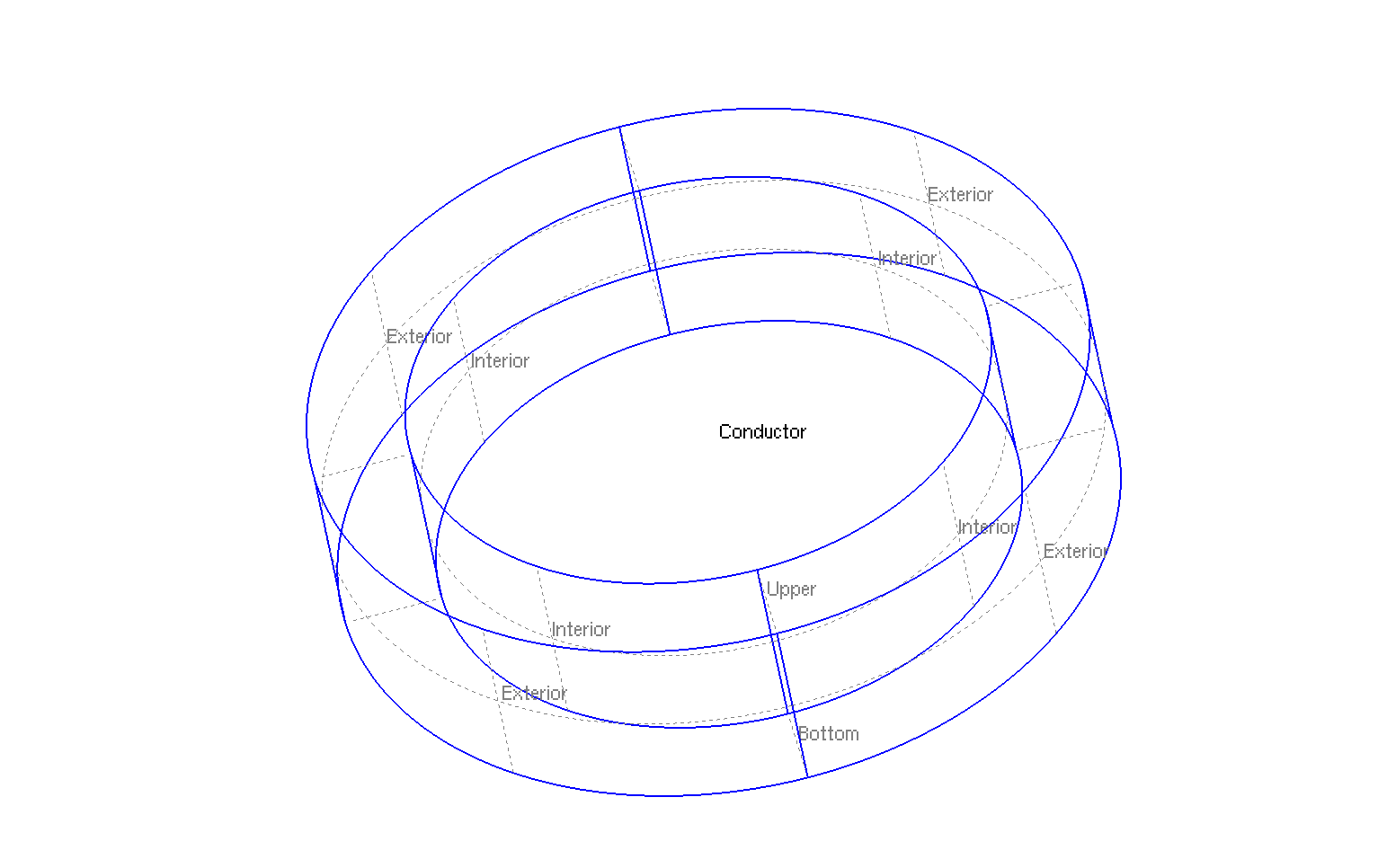
Geometry in three dimensions
|
The geometrical domains are :
-
Conductor: the torus, composed by conductive material -
InteriorandExterior: interior and exterior of ring (or right and left of rectangle in axisymmetric coordinates \((r,z)\)) correspond to \(\Gamma_R\) -
BottomandUpper: up and bottom of the ring (or up and bottom of the rectangle in axisymmetric coordinates \((r,z)\)) correspond to \(\Gamma_N\)
Symbol |
Description |
value |
unit |
\(r_{int}\) |
interior radius of torus |
\(75e-3\) |
m |
\(r_{ext}\) |
exterior radius of torus |
\(100.2e-3\) |
m |
\(z_1\) |
half-height of torus |
\(25e-3\) |
m |
6. Boundary Conditions
We impose the boundary conditions :
-
Neumann : \(\frac{\partial T}{\partial \mathbf{n}} = 0\) on
InteriorandExterior -
Robin : \(-k \, \frac{\partial T}{\partial \mathbf{n}} = h \, \left( T - T_c \right)\) on
UpperandBottom
We initialize on Conductor : \(T(t=0,r,z)=T_i\).
On JSON file, the boundary conditions are writed :
"BoundaryConditions":
{
"heat":
{
"Robin":
{
"Interior":
{
"expr1":"h:h",
"expr2":"h*T_c:h:T_c"
},
"Exterior":
{
"expr1":"h:h",
"expr2":"h*T_c:h:T_c"
}
}
}
}
On JSON file, the intial conditions are writed : .Initial conditions on JSON file
"InitialConditions":
{
"temperature":
{
"Expression":
{
"myic":
{
"markers":"Conductor",
"expr":"T_i:T_i"
}
}
}
}
7. Weak Formulation
We obtain :
8. Parameters
The parameters of problem are :
-
On
Conductor:
Symbol |
Description |
Value |
Unit |
\(Q\) |
source term |
\(\sigma \, \left( \frac{U}{2\pi \, r} \right)\) |
J |
\(U\) |
electrical potential |
\(1\) |
\(Volt\) |
\(\sigma\) |
electrical conductivity |
\(58e6\) |
\(S/m\) |
\(k\) |
thermal conductivity |
\(380\) |
\(W/m/K\) |
\(h\) |
convective coefficient |
\(8e4\) |
\(W/m^2/K\) |
\(T_c\) |
cooling temperature |
\(293\) |
\(K\) |
\(T_i\) |
initial temperature |
\(293\) |
\(K\) |
\(\rho\) |
density |
\(10000\) |
\(kg/m^3\) |
\(C_p\) |
thermal capacity |
\(380\) |
\(J/K/kg\) |
On JSON file, the parmeters are writed :
"Parameters":
{
"h":80000, // W/m2/K
"T_c":293, // K
"T_i":293, // K
"U":1, // V
// Constants of analytical solve
"a":1933.10, // K
"b":0.40041, // K
"rmax":0.0861910719118454, // m
"Tmax":364.446 // K
}
9. Coefficient Form PDEs
We use the application Coefficient Form PDEs. The coefficient associate to Weak Formulation are :
-
On
Conductor:
Coefficient |
Description |
Expression |
\(d\) |
damping or mass coefficient |
\(\rho \, C_p\) |
\(c\) |
diffusion coefficient |
\(k\) |
\(f\) |
source term |
\(\sigma \left( \frac{U}{2\pi \, r} \right)^2 = \sigma \left( \frac{U}{2\pi \, \sqrt{x^2+y^2}} \right)^2\) |
On JSON file, the coefficients are writed :
"Materials":
{
"Conductor":
{
"k":380, // W/m/K
"sigma":58e+6, // S.m-1
"rho":10000, // kg/m3
"Cp":380, // J/K/kg
"heat_c":"k:k",
"heat_f":"sigma*(U/2/pi)*(U/2/pi)/(x*x+y*y):sigma:U:x:y",
"heat_d":"rho*Cp:rho:Cp"
}
}
10. Numeric Parameters
This section show the parameters used to compute the simulation.
-
Size of mesh : \(1 \, mm\)
-
Time Parameters :
-
Time step : \(0.1 \, s\)
-
Initial Time : \(0 \, s\)
-
Final Time : \(15 \, s\)
-
-
Element type : \(P1\)
-
Solver : automatic
-
Number of CPU core : \(32\)
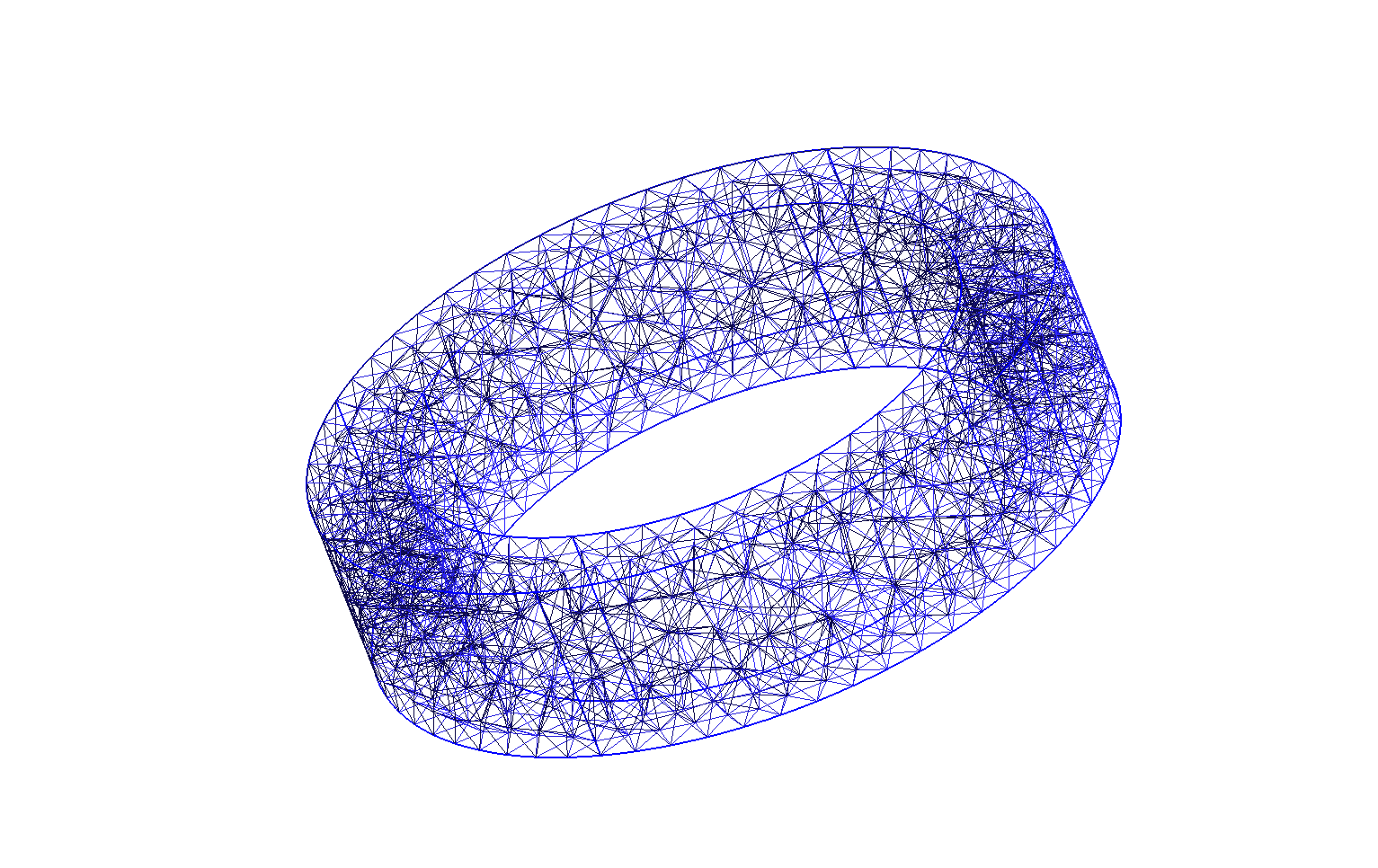
Mesh of Geometry (size of mesh \(10 \, mm\))
|
11. Results
We can vizualize the result on geometry :
Temperature \(T(K)\)
|
I plot the maximal temperature \(T_{max}\) across time :
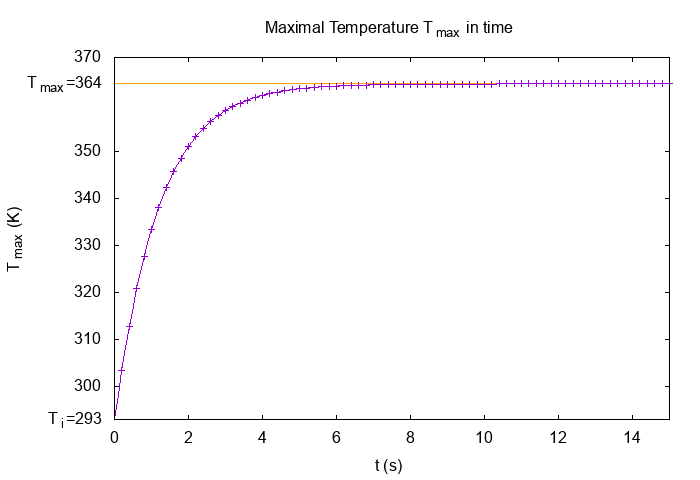
The maximum temperature increase in time and stabilized around \(T_{max}=364 \, K\).
I plot the temperature at \(t=15s\), at this time, we consider the system stationary.
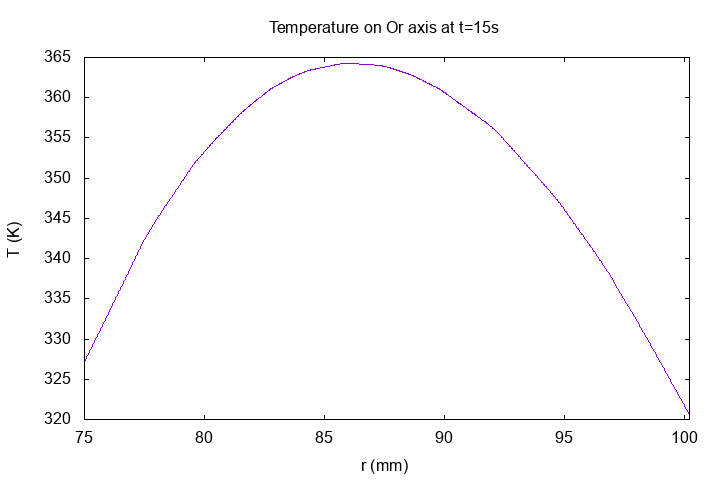
The temperature is constant by \(z\). We can see with the cut, the temperature have a profil of bell. The temperature is less at the cooled interior and exterior than the middle of torus.
12. Validation
12.1. Exact solution
In this section, we compute the exact solution of problem.
To simplify the problem, we pass on cylindric coordinates.
The problem is independant of \(\theta\) and \(z\), thus, the equation (Heat Axis) becomes :
Thus :
With \(a\) and \(b\) integrate constants.
With the Robin boundary conditions :
So :
With \(T_{c \, int}=T(r_{int})\), \(T_{c \, ext}=T(r_{ext})\), \(h_{int}=h(r_{int})\) and \(h_{ext}=h(r_{ext})\).
And, with our conditions :
The temperature can be right like :
With \(T_{max} = T(r_{max})\) the maximal temperature and \(r_{max}\) its input.
And :
12.2. Convergence Test
I compute the L2-error between the numeric result at final time \(t=t_f\) and exact solution of static problem (\(||T_{num}(t=t_f)-T_{exact}(t=t_f)||_{L^2(\Omega)}\)) for different mesh sizes.
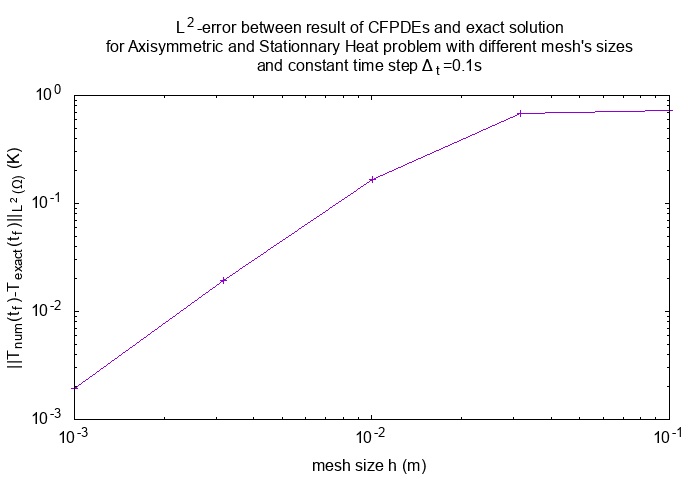
|
|
Our implementation of transient heat equation converges.